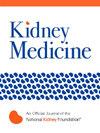Preoperative Geriatric Nutritional Risk Index Score as a Novel Predictor of Postoperative Acute Kidney Injury in Noncardiac Surgery: The NARA-AKI Cohort Study
IF 3.4
Q1 UROLOGY & NEPHROLOGY
引用次数: 0
Abstract
Rationale & Objective
Malnutrition could be a risk factor for postoperative acute kidney injury (AKI). The geriatric nutritional risk index (GNRI) is a simple indicator of malnutrition, and this study examined the association of preoperative GNRI with postoperative AKI in noncardiac surgery.
Study Design
A retrospective cohort study.
Setting & Population
Adults who underwent noncardiac surgery under general anesthesia from 2007-2011 were included. Obstetric or urologic surgery, missing serum creatinine, baseline estimated glomerular filtration rate <15 mL/min/1.73 m2, and preoperative dialysis were excluded.
Predictor
Preoperative GNRI.
Outcome
AKI within 7 days after surgery.
Analytical Approach
Multivariable logistic regression and restricted cubic spline analysis were performed to examine the association of preoperative GNRI with AKI.
Results
Among 5,148 patients, 301 (5.8%) developed AKI. After adjustment for potential confounders, preoperative lower GNRI scores were independently associated with higher incidence of postoperative AKI (adjusted OR [95% confidence interval], 1.20 [0.84-1.73], 1.37 [0.91-2.06], and 1.88 [1.11-3.20] for those with mild [92 ≤ GNRI < 98], moderate [82≤ GNRI <92], and severe [GNRI <82] malnutrition, respectively (P for trend = 0.02]). Restricted cubic spline analysis confirmed a monotonous increase in ORs for AKI at GNRI levels <98. Subgroup analyses suggested the association was similar across age, different reasons for surgery, and C-reactive protein levels (P for interaction = 0.78, 0.55, and 0.84, respectively). In sensitivity analyses, the association of GNRI with AKI was consistent using multiple imputations on missing data. Multinomial logistic regression indicated severe malnutrition tended to be associated with more severe AKI.
Limitations
The presence of residual unknown confounders is a concern although a maximal effort was made to adjust for possible confounders.
Conclusions
Lower GNRIs were independently associated with postoperative AKI irrespective of patients’ age, malignancy, or inflammation. Improvement of preoperative malnutrition may reduce postoperative AKI.
Plain Language Summary
The geriatric nutritional risk index (GNRI) is known as a simple indicator of malnutrition. Using GNRI, the association of preoperative malnutrition with postoperative acute kidney injury (AKI) was examined in noncardiac surgery. In this retrospective cohort study, adults with noncardiac surgery under general anesthesia were included. The association of preoperative GNRI with postoperative AKI was examined using multivariable logistic regression models. Among 5,148 patients, 301 developed AKI. Even after adjustment for potential confounders, the association of preoperative malnutrition with AKI was found stronger as the malnutrition became more severe. Subgroup analyses indicated the possibility that the association of malnutrition with AKI was not because of inflammation or advanced malignancy among malnourished patients. Improvement of preoperative malnutrition may reduce postoperative AKI.
术前老年人营养风险指数评分作为非心脏手术后急性肾损伤的新预测指标:NARA-AKI队列研究
目的营养不良可能是术后急性肾损伤(AKI)的危险因素。老年人营养风险指数(GNRI)是一个简单的营养不良指标,本研究探讨了非心脏手术术前GNRI与术后AKI的关系。研究设计:回顾性队列研究。背景和人群纳入2007-2011年在全身麻醉下接受非心脏手术的成年人。排除了产科或泌尿外科手术、血清肌酐缺失、肾小球滤过率基线估计≤15 mL/min/1.73 m2和术前透析。PredictorPreoperative GNRI。结果:术后7天内aki。分析方法采用多变量logistic回归和限制性三次样条分析来检验术前GNRI与AKI的关系。结果5148例患者中,301例(5.8%)发生AKI。校正潜在混杂因素后,术前较低的GNRI评分与术后较高的AKI发生率独立相关(调整OR[95%置信区间],轻度[92≤GNRI <; 98]、中度[82≤GNRI <;92]、重度[GNRI <;82]营养不良患者的OR分别为1.20[0.84-1.73]、1.37[0.91-2.06]、1.88[1.11-3.20],趋势P = 0.02)。限制性三次样条分析证实了GNRI水平下AKI的or单调增加[lt;98]。亚组分析表明,这种关联在年龄、不同手术原因和c反应蛋白水平上相似(相互作用的P值分别为0.78、0.55和0.84)。在敏感性分析中,GNRI与AKI的关联在对缺失数据进行多重拟合时是一致的。多项logistic回归显示严重营养不良倾向于与更严重的AKI相关。虽然已经尽了最大的努力来调整可能的混杂因素,但仍然存在残留的未知混杂因素。结论与患者年龄、恶性肿瘤或炎症无关,较慢的GNRIs与术后AKI独立相关。术前营养不良的改善可减少术后AKI。老年人营养风险指数(GNRI)被认为是营养不良的一个简单指标。采用GNRI,研究了非心脏手术患者术前营养不良与术后急性肾损伤(AKI)的关系。在这项回顾性队列研究中,包括在全身麻醉下进行非心脏手术的成年人。术前GNRI与术后AKI的关系采用多变量logistic回归模型进行检验。在5148例患者中,301例发展为AKI。即使在调整了潜在的混杂因素后,术前营养不良与AKI的相关性随着营养不良的加重而增强。亚组分析表明营养不良与AKI的关联可能不是因为营养不良患者的炎症或晚期恶性肿瘤。术前营养不良的改善可减少术后AKI。
本文章由计算机程序翻译,如有差异,请以英文原文为准。
求助全文
约1分钟内获得全文
求助全文

 求助内容:
求助内容: 应助结果提醒方式:
应助结果提醒方式:


